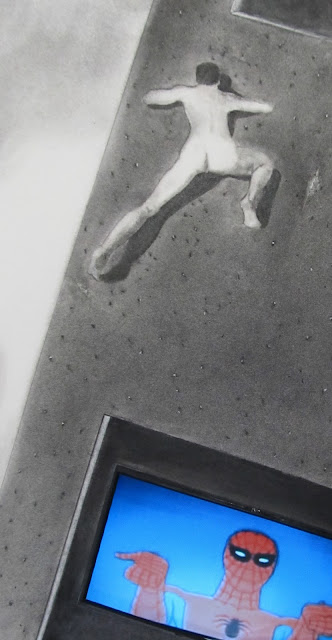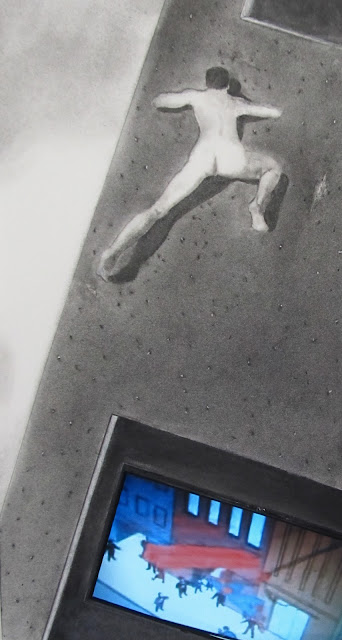On the flight over to Miami to participate at the
Context Art Miami art fair during
Art Basel Miami Beach week, I began the first of two postings discussing why visual art establishments and arts organizations of all sorts should and must participate in the visual art world's largest art party.
You can read the first part here.
As I return home,
having had a terrific fair, this second part is being written on the flight home.
The first part used
The Art League as an example of a visual arts entity (and a great one at that) that should participate in art fairs. I noted that they have several thousand members and run a very successful and important program at their space inside the
Torpedo Factory and assorted classrooms all over the area.
So the issue is, how does The Art League (again, you can fill in any of multiple DMV area membership-based art organizations) pick or select the 3-5 artists to take to an art fair?
Once again I am going to make the very important point that the "good" art fairs are nearly always tightly juried. There are many other art fairs where one just pays and anyone and everyone can go - those usually suck and unfortunately by now some DMV galleries and many DMV solo artists have discovered this (along with good Cuban food) during this last week in Miami.
And thus I noted that for Miami/NYC fairs I am thinking (in no particular order) about
Art Miami, Context,
Aqua,
Pulse,
NADA,
Affordable Art Fair(s), Scope,
Miami Project,
Untitled, Frieze... some of these are very, very hard (some nearly impossible) to get into, but they're listed nonetheless, because there is a "food chain" of art fairs, and the bottom-feeders usually spell disaster for the participants. For example, we've applied many times to
Pulse and have always been rejected. There were almost 30 art fairs in the Greater Miami area last week!
For this, The Art League would need to establish a process to pre-jury its membership to 3-5 artists and apply with those artists to an art fair. I would start with
The Affordable Art Fair in New York this coming Spring. They are close by and they are a "proven" fair. Later, for Miami, I would start with either Aqua or Context.
The Art League then would need to canvas their membership and find out who's interested in being juried for possible selection for further jurying into an art fair. Everything that I'm going to discuss below has to be clearly explained in the prospectus for this process, so that each applying artist knows exactly what this would involve.
I suspect that a large number of artists would find this attractive, and perhaps a small jurying fee ($10?) could be applied to subsidize the art fair costs (I would budget anywhere from $12-20K, depending on booth size).
I would make this jurying process independent from the Art League itself - just like they do for their monthly juried shows, and have interested artists bring their work in to be juried by an independent juror.
That juror has to be a very special juror - in fact 99.9998% of your standard-issue visual art juror (art professors, art critics, art writers, art center directors, artists, collectors, art symbiots, etc.) would guarantee a disaster to this process. There are probably less than a dozen people in the entire DMV who are qualified to jury this process, I kid thee not and I know them all.
This is a critical point, so I'm going to repeat it: The DMV the jury pool for this process is very limited and its members are only those gallerists who have successfully participated in multiple art fairs. In fact I can't think of anyone better to jury this part than me!
Whatever you do, DO NOT use an
art fair director as a juror! They are usually interested in what would make the fair look good (usually from an unsellable trendy perspective) , rather than understand the delicate balance of good art, finances and peripheral issues that come to play into this process.
The juror would pick 3-5 artists and 2-3 alternates. This is because some art fair processes do have the option to accept an application while at the same time rejecting some of the artists in that application.
So now we have a group of artists, culled from applying Art League members, ready and willing to participate in an art fair.
The actual application process is easy, so I'm not getting into that - be aware that deadlines are usually months before the actual fairs.
If accepted, the next step is transporting the artwork to the art fair, and then returning the unsold artwork back to the owners. For this, the Art League has various options.
One option would be to hire a transport company. There are dozens and dozens of specialized carriers that do this and they pick up and transport the art to your booth at the fair, and at the end pick it up from your booth and transport it back. This is the easiest and the most expensive. From here to NYC and back I would budget $1200-$2000 depending on volume. Packaging also becomes an issue here.
Another option is to rent a truck or van and schlep the work to and from the fair yourself. This is what I usually do for New York and Miami.
A third option is to have each artist (or teamed artists) bring their own work in their own cars, vans, etc.
In this example, I would offer each accepted artist the choice to also come to the fair, and help hang and help to sell their own work. This should be an option, not a requirement, as some artists would rather spend a week in Baghdad than a long weekend in an art fair dealing with art collectors; but some artists do like doing that. In any event, just "being" and seeing what goes on at an art fair is a spectacular learning opportunity for anyone involved in the visual arts.
The Art League has the luxury of having a very skilled "front desk" team that is already well-versed in the arcane art of selling artwork - so they could and should also come to the fair to handle questions and sales, etc.DO NOT send your executive director or curator to handle sales - that would be a disaster!
We're getting dangerously close to having a lot of people crowding the booth, so let's please keep the number of people hanging around the booth at all times to less than three; the artists can "float" in and out.
There is strength in numbers in many other aspects: transporting artwork, hanging it, packing it, splitting costs of hotel rooms, etc.
Before you book a hotel room anywhere in the major US cities (especially NYC) always check
www.bedbugregistry.com. Again, I kid thee not. Pick a hotel that is walking distance from the fair or public transportation to the fair.
The elephant in the room here is cost(s), but again there is strength in numbers.
Art fairs often offer discounted prices to non-profits;
Honfleur Gallery in Anacostia often participates in The Affordable Art Fair in NYC and takes advantage of this special pricing.
WPA participates (and has great success) at (e)merge and
Hamiltonian is always somewhere in Miami.
Art fair prices are different depending on the fair. You can see the booth prices for the next
Affordable Art Fair New York here. As you can see, you can actually get a booth for as low as $4600.
I'm my head I have this concept of having the selected Art League artists have a "financial stake" in this process by having them contribute some funds towards the art fair fees. Nothing works like putting your money where your mouth is. But then again, as a large organization, perhaps a more artist-friendly model would be for the Art League to cover all the art fair costs from a combination of jury entry fees and their own budget.
Of course, the Art League would also keep their usual commission on sales, so this also has a money-making angle for them.
What are the art fair costs? There are direct costs and associated costs.
Direct costs are:
(a) Cost of the basic booth
(b) Cost of additional booth stuff (extra walls, extra lights, storage)
(c) Some fairs have a "shared" advertising cost (AAFNYC doesn't)
Associated Costs are:
(a) Cost of required insurance (Art League would be able to use their current insurer or buy insurance directly from the art fair)
(b) Cost of transportation of the art. If using own vehicle, then also cost of parking it
(c) Cost of Art League staff at the fair (bus to NYC and shared hotel room and per diem for food)
(d) Cost of the juror to select the artists
Funding sources for all these costs are:
(a) Art League budget
(b) Nominal jurying fee for applying artists
(c) Commission on sales at the fair (this, of course, is putting the cart ahead of the horse)
Commercial galleries take huge chances at art fairs. My very first art fair all around cost was about $8,000 almost a decade ago - all that was charged on the gallery's credit card and we held our breath while at the fair. We sold about $30,000 worth of art, and thus after commissions to the artists we cleared $15,000 and paid off the credit card and then had $6,000 to put towards the next art fair fee.
I can count on one hand the number of times that we sold that much in any gallery art show in the DMV; and I've had a gallery here of one sort or another since 1996.
What's in it for the artists?
Usually a lot more than for the gallery. I will repeat this: more often than not, an artist reaps more good things out of an art fair than the gallery does.
These things include:
(a) Exposure to more art collectors, curators, press, etc. in a few days than in years of exhibiting art around the DMV. You will see more people in 4-5 days than in five years at a gallery in the DMV.
(b) Exposure to other galleries who may be interested in your work. I have multiple examples of this - Just ask DMV area artist
Judith Peck what has happened to her career once she started showing at art fairs.
(c) A significantly higher chance of getting critical press.
(d) A significantly higher chance of getting your work noticed by both freelance and museum curators. The chance of getting your work noticed by a DMV museum curator is probably higher than the chance of winning the lottery. Most DMV area museum curators (
AU's Jack Rasmussen being the brilliant exception) would rather take a cab to Dulles to fly to Miami to see emerging artists' works at fairs than taking a cab to see a gallery show in Georgetown.
(e) Being part of the art fair
"wake effect" --- Read about that here.
(f) A much better chance to getting invited to participate in other shows such as university shows, themed-shows, group shows, etc. Ask Virginia artist
Sheila Giolitti about that.
I hope that I've made my point, and I hope that some visual art groups and organizations are reading this.
Greater Reston Arts Center,
Blackrock Center for the Arts,
Touchstone,
Gallery West, Art League, Washington Project for the Arts,
Maryland Art Place,
Multiple Exposures,
Gallery 10,
Washington Sculptors Group,
VizArts,
Artomatic,
Waverly Street Gallery,
DC Arts Center,
DCCAH,
Target Gallery,
Torpedo Factory,
Workhouse Arts Center,
Art Gallery of Potomac,
Rockville Art League,
The Artists' Undertaking, Glen Echo... I'm looking at you.













